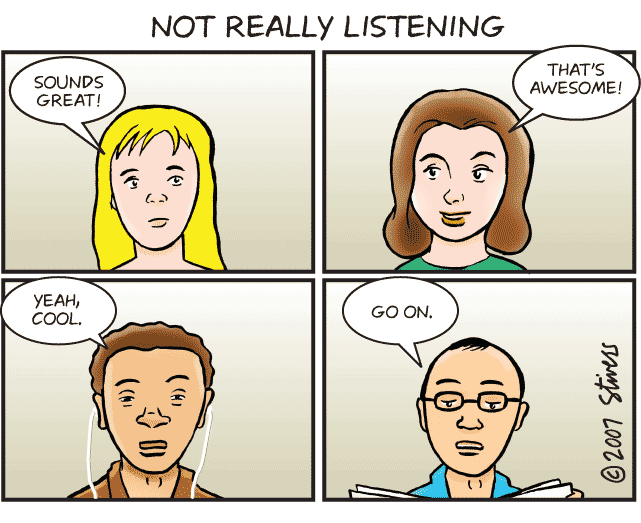We have done it every day of our lives, ever since early childhood. It is something we rarely think about when we’re doing it, but it is just as important as sharing our thoughts to with others. It is a form of communication just as much as talking is. Listening is an art which we all, including the author, can improve on. Studies show that people remember only 25 percent of what they hear. That means that we are only truly listening to a quarter of the information, thoughts, or feelings being told us. Good listening skills are important for success in college, in business meetings, in careers, and in relationships.
Many marriages can be repaired when couples listen to each other. John Gottman, psychology professor of the University of Washington, learned after 25 years of studying marriages that “active listening” is highly important in solving conflicts2. We will be looking at two types of listening: listening one on one and listening in an audience. Actively listening to a lecture or speech can be very rewarding as opposed to merely hearing a speech. The difference between listening and hearings is that hearing is just letting sound enter your ear, while listening is paying close attention to what is being said.
 We will focus first on listening in an audience. Listening to a speaker, such as a professor, is highly important if you want to succeed at your class or job. Companies lose thousands of dollars each year due to poor communication. According to a study by SIS International Research, roughly 70 percent of the employees of a business waste an average of 17.5 hours each week dealing with problems caused by poor communication1. That’s a huge chunk of time and money lost! So, how can we improve our listening skills? A study conducted by Larry Vandergrift, a University of Ottawa researcher, revealed some interesting facts about how to improve listening skills in the auditorium.
We will focus first on listening in an audience. Listening to a speaker, such as a professor, is highly important if you want to succeed at your class or job. Companies lose thousands of dollars each year due to poor communication. According to a study by SIS International Research, roughly 70 percent of the employees of a business waste an average of 17.5 hours each week dealing with problems caused by poor communication1. That’s a huge chunk of time and money lost! So, how can we improve our listening skills? A study conducted by Larry Vandergrift, a University of Ottawa researcher, revealed some interesting facts about how to improve listening skills in the auditorium.
The following seven points will help you be a better listener of a lecture1:
Many marriages can be repaired when couples listen to each other. John Gottman, psychology professor of the University of Washington, learned after 25 years of studying marriages that “active listening” is highly important in solving conflicts2. We will be looking at two types of listening: listening one on one and listening in an audience. Actively listening to a lecture or speech can be very rewarding as opposed to merely hearing a speech. The difference between listening and hearings is that hearing is just letting sound enter your ear, while listening is paying close attention to what is being said.
 We will focus first on listening in an audience. Listening to a speaker, such as a professor, is highly important if you want to succeed at your class or job. Companies lose thousands of dollars each year due to poor communication. According to a study by SIS International Research, roughly 70 percent of the employees of a business waste an average of 17.5 hours each week dealing with problems caused by poor communication1. That’s a huge chunk of time and money lost! So, how can we improve our listening skills? A study conducted by Larry Vandergrift, a University of Ottawa researcher, revealed some interesting facts about how to improve listening skills in the auditorium.
We will focus first on listening in an audience. Listening to a speaker, such as a professor, is highly important if you want to succeed at your class or job. Companies lose thousands of dollars each year due to poor communication. According to a study by SIS International Research, roughly 70 percent of the employees of a business waste an average of 17.5 hours each week dealing with problems caused by poor communication1. That’s a huge chunk of time and money lost! So, how can we improve our listening skills? A study conducted by Larry Vandergrift, a University of Ottawa researcher, revealed some interesting facts about how to improve listening skills in the auditorium. The following seven points will help you be a better listener of a lecture1:
1. Have goals for what you want to learn from the lecture or speech. Before you go to the lecture, predict what you think the speaker is going to say and think about what you would like to learn from the speech.
2. Before going to the speech, mentally review what you know about the topic of the speech. Your knowledge is a foundation which you can then build on. When you review your knowledge on the subject before the speech, you’ll be more aware of how the new information from the speech fits in with what you already know. This makes it easier to learn. Learning based on past knowledge is important for progress.
3. When you listen to the speech, listen for what is important or relevant to you and take notes. The things that stand out to you are important, and writing them down is a must. Often, we can’t easily remember everything we’ve heard.
4. Don’t get distracted. The people around you text messaging, the speaker’s resemblance to someone you know, the people standing up and leaving the lecture, and your own thoughts can cause you to get easily sidetracked. Don’t let them. Keep your eyes on the speaker and your thoughts on what is being said and what it means.
5. Don’t get thrown off by confusing or unfamiliar ideas, words, or details. Many professors and some speakers use words that are unfamiliar. Or, they may talk about things that go over your head. The key is to not be distracted from the points the speaker is trying to make.


 Artifacts depicting images of biblical events have been discovered all over the Middle East. One insightful depiction can be found in the south wall of the Great Temple of Amon at Karnak, in Egypt (5). A huge sunken-relief of Pharaoh Shishak (or Shoshenq I), with a number of small depictions of ancient Hebrews surrounding it, catches one’s attention while walking through the temple. Commissioned by Shoshenq I, the relief of the pharaoh also contains writing describing a campaign in Israel where he sacked a number of cities and took the plunder back to Egypt with him (5). The Bible records Shishak’s campaign in 2 Chronicles 12:1-9* and in 1 Kings 14:25. Rehoboam the king of Judah “forsook the law of the LORD, and all Israel with him” (2 Chron. 12:1). Then, “in the fifth year of king Rehoboam Shishak king of Egypt came up against Jerusalem, because they had transgressed against the LORD…and the people were without number that came with him out of Egypt…. And he took the fenced cities which pertained to Judah, and came to Jerusalem” (2 Chron. 12:2-4).
Artifacts depicting images of biblical events have been discovered all over the Middle East. One insightful depiction can be found in the south wall of the Great Temple of Amon at Karnak, in Egypt (5). A huge sunken-relief of Pharaoh Shishak (or Shoshenq I), with a number of small depictions of ancient Hebrews surrounding it, catches one’s attention while walking through the temple. Commissioned by Shoshenq I, the relief of the pharaoh also contains writing describing a campaign in Israel where he sacked a number of cities and took the plunder back to Egypt with him (5). The Bible records Shishak’s campaign in 2 Chronicles 12:1-9* and in 1 Kings 14:25. Rehoboam the king of Judah “forsook the law of the LORD, and all Israel with him” (2 Chron. 12:1). Then, “in the fifth year of king Rehoboam Shishak king of Egypt came up against Jerusalem, because they had transgressed against the LORD…and the people were without number that came with him out of Egypt…. And he took the fenced cities which pertained to Judah, and came to Jerusalem” (2 Chron. 12:2-4). The Victory Relief of Shoshenq I records that he attacked various cities in the northern kingdom of Israel in addition to cities in the southern kingdom of Judah (11). Further confirmation that this event recorded in the Bible and in the Temple of Amon actually occurred is found in Israel, at the site of Megiddo. At Megiddo, a section of a stela (an upright stone slab) was discovered in 1926 during some excavations (11). On this stela, commemorating Shishak’s victory, his name can clearly be seen carved into the stone (11).
The Victory Relief of Shoshenq I records that he attacked various cities in the northern kingdom of Israel in addition to cities in the southern kingdom of Judah (11). Further confirmation that this event recorded in the Bible and in the Temple of Amon actually occurred is found in Israel, at the site of Megiddo. At Megiddo, a section of a stela (an upright stone slab) was discovered in 1926 during some excavations (11). On this stela, commemorating Shishak’s victory, his name can clearly be seen carved into the stone (11).  Depictions of events described in the Bible are not limited to Egypt. Located in northern Iraq in the ruins of ancient Nineveh is the Palace of Sennacherib. All that is left of the magnificent home of the Assyrian king, King Sennacherib, is the palace foundation and some of its walls. One particular wall is still mostly intact.
Depictions of events described in the Bible are not limited to Egypt. Located in northern Iraq in the ruins of ancient Nineveh is the Palace of Sennacherib. All that is left of the magnificent home of the Assyrian king, King Sennacherib, is the palace foundation and some of its walls. One particular wall is still mostly intact. 




 Vision is important to most people. We would have difficulty navigating our surroundings and writing articles, like this one, if we did not have it. Millions of people around the world do all they can to improve their sight. Some get contact lenses and glasses, spending hundreds of dollars, while others receive laser-eye-surgery, spending thousands. This question should be of interest to those who want to have good vision: “How do we see images?”
Vision is important to most people. We would have difficulty navigating our surroundings and writing articles, like this one, if we did not have it. Millions of people around the world do all they can to improve their sight. Some get contact lenses and glasses, spending hundreds of dollars, while others receive laser-eye-surgery, spending thousands. This question should be of interest to those who want to have good vision: “How do we see images?”  lling light levels, a sensor for capturing the images projected on it, and a lens that automatically focuses (8). The sclera is the white part of the eye. Like a camera’s interior, the sclera is brown, or dark, on the inside. This allows it to absorb light to keep the images received by the brain from being washed out. Connecting to the sclera and covering the iris is a transparent membrane called the cornea. The cornea is a crystal-clear membrane which consists of five layers, totaling half a millimeter thick (2). It alone accounts for two-thirds of the eye’s focusing power (2).
lling light levels, a sensor for capturing the images projected on it, and a lens that automatically focuses (8). The sclera is the white part of the eye. Like a camera’s interior, the sclera is brown, or dark, on the inside. This allows it to absorb light to keep the images received by the brain from being washed out. Connecting to the sclera and covering the iris is a transparent membrane called the cornea. The cornea is a crystal-clear membrane which consists of five layers, totaling half a millimeter thick (2). It alone accounts for two-thirds of the eye’s focusing power (2).